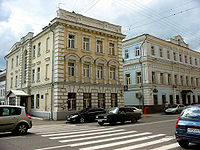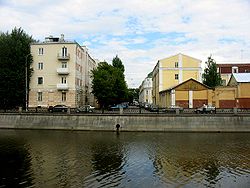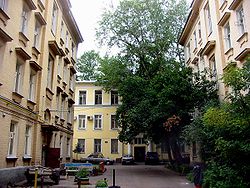
Sadovnicheskaya Street
Encyclopedia

Moscow
Moscow is the capital, the most populous city, and the most populous federal subject of Russia. The city is a major political, economic, cultural, scientific, religious, financial, educational, and transportation centre of Russia and the continent...
, Russia
Russia
Russia or , officially known as both Russia and the Russian Federation , is a country in northern Eurasia. It is a federal semi-presidential republic, comprising 83 federal subjects...
, on a narrow island
Balchug
Balchug , also known as Bolotny Ostrov , is an island in the very centre of Moscow, Russia, squeezed between the Moskva River and its old river-bed which was turned into the Vodootvodny Canal in 1786...
between Moskva River
Moskva River
The Moskva River is a river that flows through the Moscow and Smolensk Oblasts in Russia, and is a tributary of the Oka River.-Etymology:...
and the parallel old river bed (Vodootvodny Canal). The street runs from Balchug Street (across the Kremlin
Kremlin
A kremlin , same root as in kremen is a major fortified central complex found in historic Russian cities. This word is often used to refer to the best-known one, the Moscow Kremlin, or metonymically to the government that is based there...
) south-east to the Garden Ring
Garden Ring
The Garden Ring, also known as the "B" Ring , is a circular avenue around the central Moscow, its course corresponding to what used to be the city ramparts surrounding Zemlyanoy Gorod in the 17th century....
.
History
Historical neighborhood of Sadovniki (lit. Gardener's) goes back to the 14th century gardens of prince Vasili I of RussiaVasili I of Russia
Vasiliy I Dmitriyevich was Grand Prince of Moscow from 1389.He was the oldest son of Dmitri Donskoi and Grand Princess Eudoxia, daughter of Grand Prince Dmitry Konstantinovich of Nizhny Novgorod.-Domestic policy:...
. The garden itself was placed directly opposite the Kremlin and doubled as a fire barrier within a wooden city. Adjacent garden workers' settlement
Sloboda
Sloboda was a kind of settlement in the history of Russia, Belarus and Ukraine. The name is derived from the early Slavic word for "freedom" and may be vaguely translated as "free settlement"....
eventually gave name to Sadovniki and Sadovnicheskaya street. Other streets with the same name also existed in Moscow, but were eventually renamed. The remote district of Nagatino-Sadovniki
Nagatino-Sadovniki District
Nagatino-Sadovniki District is an administrative district of Southern Administrative Okrug, and one of the 125 raions of Moscow, Russia....
was named in a similar manner, centuries later. Downtown Sadovniki remained a quiet, rural community. Annual floods and migrations of river bed through the floodlands discouraged capital construction. As if it wasn't enough, the southern suburbs were the first to be looted and burnt down during the enemy raids.

Moscow Military District
The Moscow Military District was a military district of the Soviet Armed Forces and the Armed Forces of the Russian Federation. In 2010 it was merged with the Leningrad Military District, the Northern Fleet and the Baltic Fleet to form the new Western Military District.-History:In the beginning of...
. Dams intended to control floods (1836) also raised river level, improving commercial shipping. They were imperfect and couldn't help in case of draught or flood: in 1908, Moskva River
Moskva River
The Moskva River is a river that flows through the Moscow and Smolensk Oblasts in Russia, and is a tributary of the Oka River.-Etymology:...
completely flooded the island (water level exceeded 7 meters above present-day summer average).
By the end of 19th century, Sadovniki became a working-class community. In 1880s, the street saw heavy industrial construction (first electrical powerplant, 1887, textile mills). Former warehouses and farms were built out to five-story residential houses and hotels.
Modern times
Relatively few historical buildings were lost in the Soviet time. The classical three-story waterfront mansion (now at 43 Sadovnicheskaya), which was in the way of housing construction after World War IIWorld War II
World War II, or the Second World War , was a global conflict lasting from 1939 to 1945, involving most of the world's nations—including all of the great powers—eventually forming two opposing military alliances: the Allies and the Axis...
, was carefully lifted with hydraulic jacks and moved south to its present location. Grand Stalinist construction concentrated on the Moskva river front, while Sadovnicheskaya street (just a hundred meters south) remained mostly intact. An important late Constructivism
Constructivist architecture
Constructivist architecture was a form of modern architecture that flourished in the Soviet Union in the 1920s and early 1930s. It combined advanced technology and engineering with an avowedly Communist social purpose. Although it was divided into several competing factions, the movement produced...
landmark in Sadovniki is the Textile Institute, facing near the Ustinsky Bridge.
Electrical streetcar served the eastern part of the street from 1913 to 1963 (photo: existing streetcar line crosses the street).
In 1939, the street was renamed to Polina Osipenko Street, commemorating the death of a pilot. In 1991, Sadovnicheskaya was restored, while another Osipenko street was created in distant Vnukovo district.
In 1967, a five-story house at the corner of Sadovnicheskaya and Garden ring (No.77) was destroyed by explosion. No reliable sources exist to the number of killed or the nature of a blast (either a gas pipe leak or WWII ammunition). The site stood vacant until 2006.

Bolshoy Ustinsky Bridge
Bolshoy Ustinsky Bridge is a steel arch bridge that spans Moskva River near the mouth of Yauza River, connecting the Boulevard Ring with Zamoskvorechye district in Moscow, Russia...
:
- Sadovniki West (including the Balchug street). The most densely built part of the island is almost all office space, uninhabited at night. Also houses Moscow's first electrical powerplant (still active); offices are traditionally occupied by electrical (MosenergoMosenergoMosenergo is the Russian largest power generating company operating on fossil fuel and the world largest thermal generation company. In addition to electric power it also generates and sells heat for consumers in Moscow and the Moscow Oblast...
) and oil companies. - Sadovniki East. A mixed residential, educational and industrial neighborhood, Sadovniki East retained most of the traditional Zamoskvorechye air. Recent wave of development replaced the old textile mill with a block-sized office compound. Adjacent block (near Zverev BridgeZverev BridgeZverev Bridge is a pedestrian arch bridge that spans Vodootvodny Canal in Zamoskvorechye district of downtown Moscow, Russia. It was built in 1930 by N.Ya.Kalmykov and I.A.Frantsuz ....
) was condemned for redevelopment, residents evicted in 2004, but no work ever started. Other than that, 19-th century architecture remains remarkably well preserved. Military still controls sizeable properties in eastern part, which probably explains the preservation of social and architectural diversity here.

Notable educational and cultural facilities
- Church of St.Nicholas (1759), 1st Raushsky 1
- Church of St.George (1653), Sadovnicheskaya, 8
- University of Design and Technology (former Textile Institute), Sadovnicheskaya, 33
- School 518School 518School 518 is a high school in the historical Balchug area of Moscow, Russia. Designed by Ivan Zvezdin and completed in 1935, it is the only listed postconstructivist memorial building in the city...
, the only listed postconstructivistPostconstructivismPostconstructivism was a transitional architectural style that existed in the Soviet Union in the 1930s, typical of early Stalinist architecture before World War II. The term postconstructivism was coined by Selim Khan-Magomedov, a historian of architecture, to describe the product of avant-garde...
memorial building in Moscow - Gerschwin school of music - Sadovnicheskaya, 48
- Moscow International House of MusicMoscow International House of MusicThe Moscow International Performing Arts Center was officially opened on September 28, 2003 with the debut of a new orchestra, the National Philharmonic of Russia under musical director Vladimir Spivakov...
- located across the Garden Ring - Maimonides Academy, Sadovnicheskaya, 52/45
Subway and railroad access
- Paveletskaya-RadialnayaPaveletskaya-RadialnayaPaveletskaya is a Moscow Metro station on the Zamoskvoretskaya Line. It was opened in 1943 and was designed by S.V. Lyashchenko and E.S. Demchenko. Paveletskaya features tall white marble pillars decorated with the hammer and sickle and a high, arched ceiling...
, Paveletskaya-KoltsevayaPaveletskaya-KoltsevayaPaveletskaya is a station on the Koltsevaya Line of the Moscow Metro. Opened on 1 January 1950 as part of the first segment of the fourth stage, the station is a pylon-trivault built in the style of the late 1940/early 1950s Stalinist Architecture to a design by architects Nikolai Kolli and I.Kasetl...
, Paveletsky Terminal - Sadovniki east - TretyakovskayaTretyakovskayaTretyakovskaya is a cross-platform station on the Moscow Metro serving the Kaluzhsko-Rizhskaya and the Kalininskaya Lines. It is named after the nearby State Tretyakov Gallery. Unlike Kitay-gorod which was purpose-built as a cross-platform interchange station, Tretyakovskaya operated normally...
, NovokuznetskayaNovokuznetskayaNovokuznetskaya is a Moscow Metro station on the Zamoskvoretskaya Line.The station was opened on 20 November 1943.- History :Construction of the station began shortly after the launch of the second stage in 1938. Despite the World War II the station was opened on time. Later in 1978 the platform...
- Sadovniki west, east via Zverev BridgeZverev BridgeZverev Bridge is a pedestrian arch bridge that spans Vodootvodny Canal in Zamoskvorechye district of downtown Moscow, Russia. It was built in 1930 by N.Ya.Kalmykov and I.A.Frantsuz ....
Also within 20 minutes walk from Kitay-Gorod
Kitay-Gorod (Metro)
Kitay-gorod is a Moscow Metro station on the Kaluzhsko-Rizhskaya and Tagansko-Krasnopresnenskaya lines. It is one of four stations within the Moscow Metro network providing cross-platform interchange ....
, Taganskaya-Radialnaya
Taganskaya-Radialnaya
Taganskaya is a Moscow Metro station in the Tagansky District, Central Administrative Okrug, Moscow. It is on the Tagansko-Krasnopresnenskaya Line, between Kitay-gorod and Proletarskaya stations....
, Taganskaya-Koltsevaya
Taganskaya-Koltsevaya
Taganskaya is a station on the Koltsevaya Line of the Moscow Metro. Opened on 1 January 1950 it was part of the first segment of the fourth stage of the system...
.

